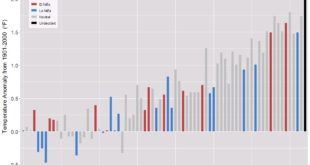 Climate Central has your answer with their post, Here’s How Frost-Free Season Affects Allergy Season (4/4/18). You will find a drop down menu to produce graphs like this one for Grand Rapids, which has seen as average increase of about 25 frost free days. On the downside,
Climate Central has your answer with their post, Here’s How Frost-Free Season Affects Allergy Season (4/4/18). You will find a drop down menu to produce graphs like this one for Grand Rapids, which has seen as average increase of about 25 frost free days. On the downside,
A study sampling 10 locations from Texas to Saskatoon, Canada indicated that pollen seasons lengthened between two to four weeks from 1995 to 2009, with the largest increases in the northernmost areas.
In addition, increasing atmospheric carbon dioxide enhances photosynthesis in plants, meaning that they produce more pollen.
They don’t provide the data, unfortunately, but they do provide a clear methodology so that you can create the data set for your city. You can get weather data from NOAA Climate Data Online. There is great potential here for student projects in statistics courses.
